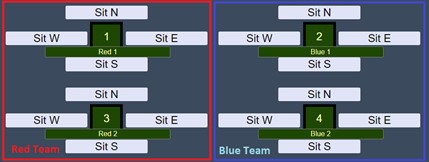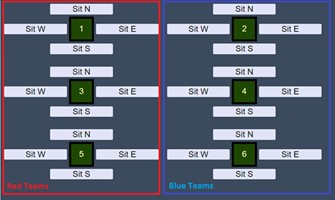This guide is for those who have already seen Running an event. After you have looked here, at this chapter, we recommend that you look at these chapters:
updated 14 April 2025
RealBridge uses the Neuberg Formula.
The Howell movement which is used in RealBridge for tables 2 to 12 can be downloaded here.
The movement is described with numbers denoting pair numbers. Each row in the table denotes a round. In round 1, pair 1 plays pair 2, pair 3 plays pair 4, etc. The first number in the tuple is the NS pair, and the second is EW.
Note: a Howell must have at least two tables. If you try to start a 1-table Howell, you will see an error message and you won't be able to start it.
In a Swiss or Round Robin teams, using VPs, with an odd number of teams, sit-out matches are scored as 12 VPs.
Similarly, in a pairs using VPs, with an odd-number of pairs, sit-out matches are scored as 12 VPs.
The score for a sit-out can be changed using the config-file parameter, vp_score_for_sitout. See RealBridge Config Files
These results are included in the USEBIO file.
See here for the multi session round robin guide
.jpg)
.jpg)
In Swiss teams with an odd number of teams, you can choose to have a triple (that is, a three-way match) each round, instead of a sitout. This is set in Session settings, Options, Swiss: odd number of teams.
While the rest of the teams play a normal Swiss match, the teams in the triple play two half-matches, in a three-team round-robin.
If there are an odd number of boards per round, the teams in the triple play one fewer board. eg:
The EW pairs in the triple are moved automatically by RealBridge at the start of each half-match.
There is no scoring break between the two half-matches.
No comparisons are visible to the players until they have completed both half-matches.
The triple uses the same boards as the rest of the matches, and one extra half-set. The board numbers used are in ascending order, so a team that is not in a triple will miss out some board numbers. eg With 8-board rounds:
With teams A, B and C, with 8-board rounds:
| First half-match: |
A-NS vs C-EW |
B-NS vs A-EW |
C-NS vs B-EW |
| Second half-match: |
A-NS vs B-EW |
B-NS vs C-EW |
C-NS vs A-EW |
The system assigns the lowest-scored teams to the triple, except that if possible it avoids:
As with standard Swiss assignments, you can see who will play in the triple using the Show Draw button in the Advanced menu. For example:

If you start a Swiss Teams with triples and an odd number of boards per round, you will see the message "Odd number of boards-per-round - teams in triple play one fewer board per round." This is a warning that on each round the teams in the triple will play one fewer board than the other matches. If you are happy with this, go ahead and start the session.
In Session settings choose Practice. Choose typically either 20, or 32 boards. Choose 1 round. Add some tables. Name them if you want. Open and start the session as normal. Players can join and sit in the seats. If you need to add more tables, you can do via the normal functionality for adding late tables. The logging system only charges for tables that were used.
(updated 25 January 2022)
Teams of 8 or more is played between two (or more) large teams. Each team is made up of several teams of four (“constituent teams”). Each constituent team plays a match against each of the opposing constituent teams. In this example, the Red Team are sitting at tables 1 and 3. The Blue Team are sitting at table 2 and 4.

This is the bare minimum you need to know a teams of 8 session with 2 teams (like the figure above).
To make a simple teams of 8 session:
(Note: No players will ever need to leave their seats.)
The overall team name is constructed from similar components in the table names. For example, if there are tables with the names "Manchester A" and "Manchester B", the overall team name is "Manchester". It is only the first part of the name in common that is used. This means the following naming conventions will NOT work "A:Manchester" and "B:Manchester" as there is no similar component at the beginning of the name. Finally, the way that RealBridge constructs the overall team name is based on the big team size and spacing elements. If you are using the Getting Started config file, this is straightforward as the team names are already included. You can simply change the first part of the team name to personalise it.
Team – Made up of several constituent teams, for example, players from a particular club. Eight or more players per team.
Constituent team – A team of four, forming part of the larger team. This is different from a standard round-robin where each group of four is a team of its own.
Note: The numbering of the constituent teams in this section is the same as the table number.
You can set up the config file for teams of as many players as you like, for example, the figure below shows teams of 12.

There are three supported methods of scoring supported by RealBridge. To select a scoring method, you must change the big_team_scoring to the USEBIO descriptor: "ximps", "imps" or "agg".
|
No |
Main method |
Further IMP and VP comments |
USEBIO descriptor |
Recommended |
Example event |
|
1 |
X-IMP, then add 1. X-IMP within the team. Every pair compares its scores with two separate team-mates. 2. Add all the XIMPs for all pairs. |
Option to convert to VPs after each round |
XIMPS |
Yes |
· Tollemache |
|
2 |
IMP, then add 1. Scoring initially as two teams-of-4. 2. Then adding the net IMPs won or lost by each such team. |
Option to convert to VPs after each round |
IMPS |
Yes |
· Garden Cities · Presidents Cup · IBU Interprovincial Championship · WBU National Teams-Of-Eight-Final |
|
3 |
Add, IMP at the end 1. Add up scores for each board. 2. Then IMP each board. |
Standard IMP
|
AGG |
No |
· Eastern Counties League |
In the calculations, team A play team X; when team A are N/S their results are A and B, when team X are N/S their results are X and Y
Normal score on the board = imp(A − X) + imp(B − X) + imp(A − Y) + imp(B − Y)
Normal score on the board = imp(A − X) + imp(B − Y)
Normal score on the board = imp(A − X + B − Y)
There are several ways in which you can set up this session. The standard way would be as follows:
For two teams of eight.
{
"auto_compass_switch": 1,
"big_team_size": 8,
"big_team_spacing": 2,
"big_team_scoring": "imps",
"scoring_break": true,
"scoring_method": 17,
"num_tables": 4,
"team_names": [ "Home A", "Away A", "Home B", "Away B" ],
"match_assignments": [
[ 2, 1, 4, 3 ],
[ 4, 3, 2, 1 ]
],
"num_rounds": 2
}
Download Config File (Right-click and save)
The match assignments here follow the example given in Section 1.
If you are running a session with teams of more than 8, you will need to change big_team_size and big_team_spacing.
big_team_size is the number of players in the entire team. For example, in teams of 8, the big_team_size is 8.
big_team_spacing is essentially the number of entire teams. If you have 2 teams of 8, leave the big_team_spacing at 2. If you have for example 6 teams of 8, you should change big_team_spacing to 6. This means that every 6th table will be on the same team.
Please note, for any teams of 8 or more session, the correct match_assignments will need to be included. The following are the correct movements for a 2 teams of 12 and teams of 16 event.
|
Teams of 12 (Two Teams) |
Teams of 16 (Two Teams) |
[ [2,1,4,3,6,5], [4,5,6,1,2,3], [6,3,2,5,4,1] ] |
[ [2,1,4,3,6,5,8,7], [4,7,6,1,8,3,2,5], [6,5,8,7,2,1,4,3], [8,3,2,5,4,7,6,1] ] |
For the full PBN file (which contains the bidding and play at each table):
Note: The “Home” and “Away” designations are just arbitrary values that are assigned in the PBN file, for compatibility with other systems. They do not affect any functionality within RealBridge.
Example of team data
|
Table and teams |
RealBridge Full PBN |
|
Table 1: NS = London EW = Paris |
[Table "1"] [Room "Closed"] [HomeTeam "Paris"] [VisitTeam "London"] |
|
Table 12: NS = Paris EW = London |
[Table "12"] [Room "Open"] [HomeTeam "Paris"] [VisitTeam "London"] |
Special extra data in "PBN with Play"
The "PBN with play" file contains extra data in a comment line starting with “% RBDATA”. This is used to record additional information about the play, outside the scope of the PBN spec. The information included is:
This is mainly intended for use when the file is imported into another RealBridge session, but consumers of the PBN file are welcome to use it. For further information please contact support@realbridge.online
If a result in the PBN file was an external result created by import from an input PBN file, the PBN record contains the comment “% RBIMPORT”. This is used by RealBridge to avoid duplicating a result with bi-directional imports. Consumers of the data may find this useful to avoid ingesting a result that had originally been imported from another session.